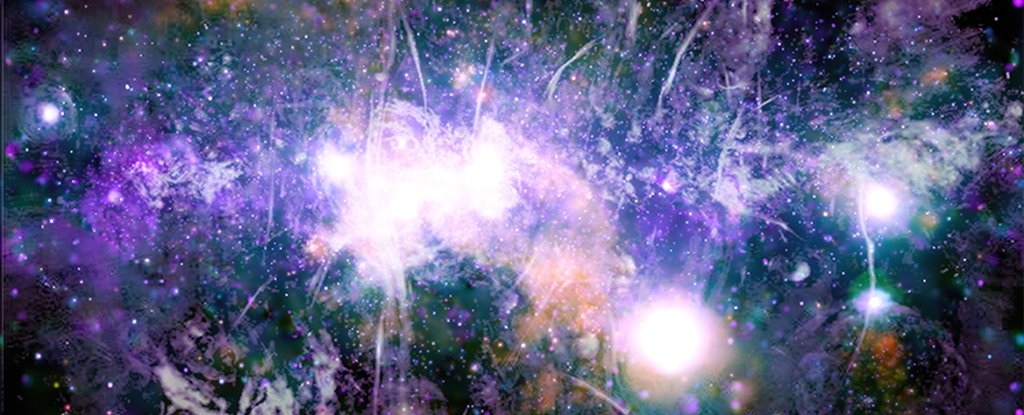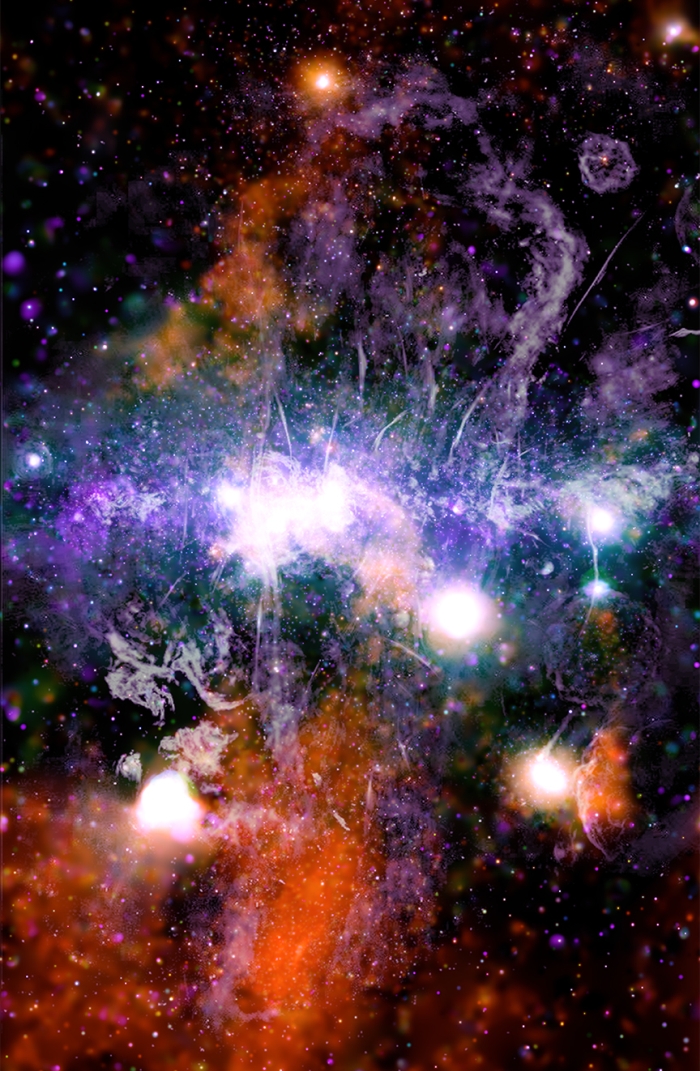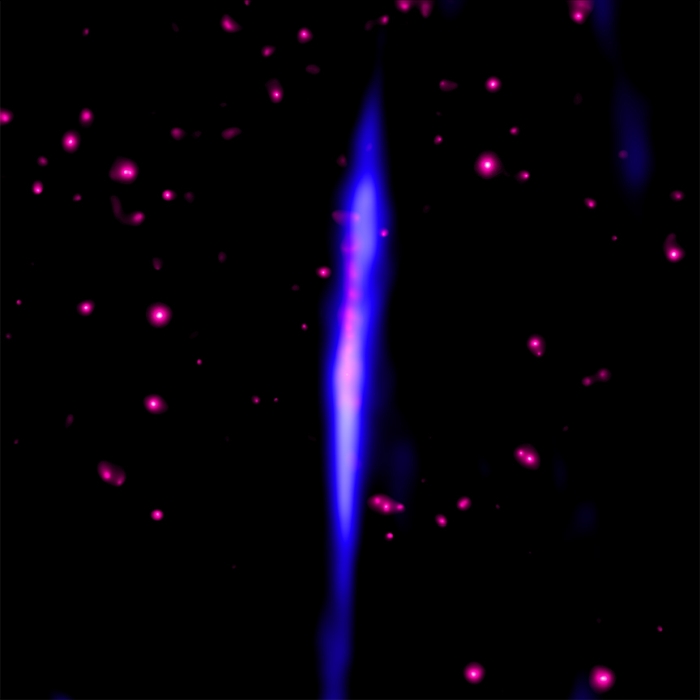
Posted on 05/28/2021 8:20:46 AM PDT by Red Badger

(NASA/CXC/UMass/Q.D. Wang; NRF/SARAO/MeerKAT) SPACE -------------------------------------------------------------------------------
The center of the Milky Way is a strange and wild place.
There dwells our galactic nucleus - a supermassive black hole 4 million times the mass of the Sun, a beast named Sgr A*. It's probably the most extreme environment in our galaxy, dominated by Sgr A*'s gravitational and magnetic fields.
It's also very hard to see into, even though it's only 25,800 light-years away: The region is shrouded by thick clouds of dust and gas that obscure some wavelengths of light. But if we use technology to tweak our vision into the invisible wavelengths, beyond the narrow capabilities of our eyes, we can begin to see some of the strange processes taking place therein.
Using the powerful Chandra X-ray Observatory space telescope and the MeerKAT radio telescope, astronomers have given us just such a view. They have combined these images for a panoramic mosaic that shows superheated gas threads and magnetic fields in "unprecedented" detail.
And, in a new paper, astronomer Daniel Wang of the University of Massachusetts Amherst has described these features in detail - including one particularly intriguing thread that glows brightly in both X-ray and radio wavelengths, intertwined.
"This thread reveals a new phenomenon," Wang said. "This is evidence of an ongoing magnetic field reconnection event."

(NASA/CXC/UMass/Q.D. Wang; NRF/SARAO/MeerKAT)
The entire image is fascinating. X-radiation is depicted in orange, green, blue and purple, representing different energies, and the radio wavelengths in gray and lilac. Above and below the galactic plane, two huge plumes of gas extend 700 light-years.
The southern one appears to be associated with the giant radio bubble only just discovered in 2019, thought to be the result of recent activity by Sgr A* (not to be confused with the much larger Fermi bubbles or eROSITA bubbles).
The fascinating gas thread, named G0.17-0.41, appears in the southern lobe - a long, slender structure 20 light-years long, but only 0.2 light-years wide.
The X-radiation is embedded within a radio filament, and its profile suggests that radio filament is a magnetic field. The shape and spectral properties of these associated elements suggest that the thread is the result of magnetic reconnection - a violent event that occurs when magnetic field lines aligned in opposite directions collide, break apart, and reconnect.

G0.17-0.41. (NASA/CXC/UMass/Q.D. Wang; NRF/SARAO/MeerKAT)
During this process, which rearranges the magnetic field, magnetic energy is converted into kinetic energy and heat. Usually, though, this process isn't energetic enough to produce X-rays - but magnetic fields in the galactic center are much more powerful.
The filaments' location on the edges of the bubbles suggests that the magnetic reconnection may be triggered by collisions between clouds of gas. As material is pushed away from the outburst at the galactic center, it collides with gas in the interstellar medium, which in turn triggers the reconnection.
This could be partially responsible for heating the gas in the region, and suggests some interesting implications. Because most reconnection events will be too faint, or too diffuse in X-rays to be detected by our current methods, it's likely that G0.17-0.41 represents "only the tip of the reconnection iceberg in the galactic center," Wang wrote in his paper.
VIDEO AT LINK...........................
Because reconnection events may play a role in heating interstellar plasma, the acceleration of cosmic rays, interstellar turbulence and the formation of interstellar structures, he believes that filaments like G0.17-0.41 may be an excellent laboratory for understanding the physics of interstellar magnetic reconnection.
"The galactic center is a truly complex system, involving not only interplay among various stellar and interstellar components, plus Sgr A*, but also inflows and outflows, multiple energy sources, as well as heating and cooling mechanisms," he wrote.
"A comprehensive study of the galactic center with this complexity will require truly a multi-wavelength approach, together with dedicated theoretical and computer simulations. Ultimately, what we learn from the GC ecosystem and its connection to larger scale structures will provide us with insights into the working of similar extreme regions in other galaxies."
The research has been published in the Monthly Notices of the Royal Astronomical Society:
https://academic.oup.com/mnras/article-abstract/504/2/1609/6255245
---------------------------------------------------------------------
In time, the universe entire will eventually experience a state of 'heat death' where no chemical reactions can occur. An act of destruction so complete that even the act itself will not be remembered, to quote the late Heinz Pagels.
Seeing as all of this is many billions of years from now, I'm not worrying about it much. $;-)
I don’t agree that the universe will die a cold death.
If Einstein’s picture of Space-Time is correct, that it is like a rubber sheet with mass depressing it [gravity wells] in all it’s different forms and locations, then even if there were only two black holes left and they were trillions of light years apart, they would eventually collide............
Read it many times.......................
Thanks!
Asimov’s story is very interesting—no doubt.
But—it is based on extrapolation of our present knowledge—which will probably be laughably obsolete in a few hundred years.
One way to think about this is to take a look at the 1494 Treaty of Tordesillas—where the Kings of Spain and Portugal met with the Pope and divided the world in halves for their two empires.
They could never have imagined the world of today.
So it will be for current hairless apes—the universe is _not_ going to play by our “laws” or “rules”.
Celestial FiReworks or What?!?
Wow!!
Soap&Suds
Rinse
Wring Dry
Repeat
—
The Universe(s) recycle , Do you? :-}

I captured this galaxy last week. It's called M51 Whirlpool Galaxy. It's one of my favorites to visit.
M51 Galaxy and its companion, NGC 5195, is located about 30 million light years away. M51 estimated diameter is 76,000 light-years. It is believed a large black hole resides at the galaxy core or center.
225x30' ISO 2500 - Total iteration time 1h52m30s.
Whirlpool Galaxy with it’s Maytag-along Galaxy...........
Larry Niven did a whole series of SF stories about this phenomenon. TO the point, a race of aliens called Puppeteers were running the galaxy for eons — sort of like how the Dutch ran circles around everybody in Europe when their trading empire was at its peak. Then, the Puppeteers hired some guy to go take a peak at the center of the galaxy in an experimental ship they developed. He came back with a report that, yes, the center was a black hole. Worse, it had consumed a bunch of stars, causing them to explode. The products of this was a wave of high-energy, fatal, sanitizing particles coming thisaway. That wave would arrive in 20k years. Oops. Puppeteers were notorious cowards. So, they dropped everything and scrammed for the next galaxy over. This collapsed the entire galactic economy for years.
There were about a dozen follow-on novels about this. Fascinating read if you are willing to suspend disbelief on a few things.
It’s interesting as NGC 5195 appears as part of the M51 system but it’s not. NGC 5195 is actually separate and moving in behind M51.
And then it won’t be seen anymore, like the Kenmore Galaxy.................
I pity any life forms that may have developed that close to all the chaos and gravity well ( if such a thing were possible and observable), but I’m sure their end was quick, although we observing it from farther away would see it as an agonizing slow death.

Filaments, Schmilaments! What I see is a giant, heart-stopping demon with its shoulders and neck, particularly its spine, in red. Its purple left horn is broken off and the eye at the base of its skull under its good horn is fixed squarely on us! Ha, ha... I cannot look at random patterns and not see stuff... It's the me, before my mathematical and scientific training came along and tried to fix my brain. And it refuses to die, lol.
Very nice find. Fascinating. Thx.
Too much radiation for anything to develop...................
I see COOKIE MONSTER!.....................
Speaking of which, Andromeda seems to be getting awfully familiar. We weren’t even properly introduced IMHO.
Galaxies can merge and form bigger galaxies....................
Yeah but with casualties. Gravity is gravity, and Newton Third Law is still useful, if not precise.
Are there any intergalactic orphan stars out there?...................
Disclaimer: Opinions posted on Free Republic are those of the individual posters and do not necessarily represent the opinion of Free Republic or its management. All materials posted herein are protected by copyright law and the exemption for fair use of copyrighted works.